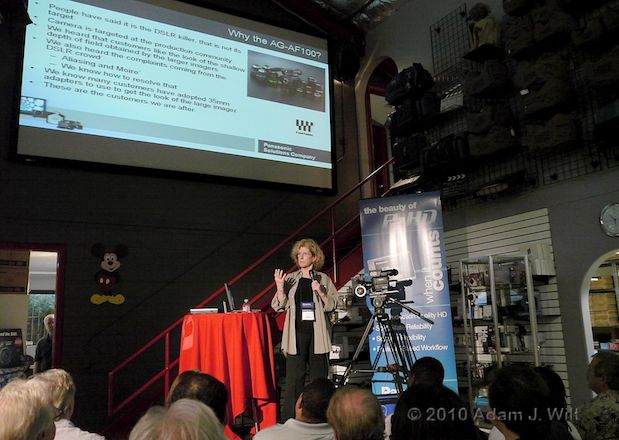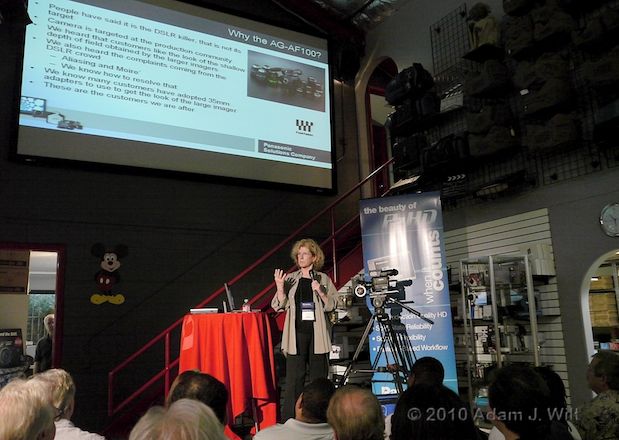
Thursday, 4 November 2010: Panasonic’s Jan Crittenden Livingston appeared at Hollywood rental and sales facility Birns & Sawyer to show off a prototype AG-AF100 Micro Four Thirds cine-style camcorder. I was in town for the Createasphere 3D Workshop, so I stopped by for a look. Herewith, my notes and observations.
The AG-AF100 is a single-sensor handheld camera with interchangeable lenses. It’s based on the Micro Four Thirds (MFT) format, using a bayonet-style lens mount with a ~20mm flange depth in front of an 10.6×18.8mm CMOS sensor—roughly 80% the size of a 35mm motion picture film frame (the flip side is that a film lens on the AF100 will seem about 25% “more telephoto”; a 50mm on the AF100 will have roughly the same angle of view as a 60mm or 65mm on a film camera). Some say the AF-100 will be the “DSLR Killer” for video applications; Panasonic qualifies this as a “DSLR killer for serious uses”. The body alone is (or will be) $4995, so it’s not for the $2500 DSLR crowd.
The AG-AF100 with 50mm CP.2 and Cinetech follow-focus (with tiny scale-illuminating LED light).
The AF100 will show no moir©, no color shimmering or aliasing. Its anti-aliasing / optical low-pass filter is optimized for 1080p and 720p (when Jan brought the AF100 to the 3D workshop and had it hooked up to a 25″ display, the images looked smooth, natural, unaliased, and very clean).
Its CMOS sensor is “best in class” with fast scanning for minimal skew. Yes, it showed some jellocam on fast motion, but it took some pretty severe whip-panning to make it at all noticeable.
The shallow flange depth (MFT is a “mirrorless” or “live view” format in still cameras, so there isn’t the need for a deep mirror box behind the lens as on reflex cameras) allows just about any lens other than C-mount lenses to be attached with an adapter (the demo camera had Illya Friedman’s Hot Rod Cameras PL-mount adapter on it with a Zeiss 50mm Compact Prime CP.2 lens and a Cinetech follow-focus). Jan had a Novoflex Nikon F to MTF adapter with her, and she said a Birger EOS adapter (with, presumably, electronic aperture control for Canon’s lenses) may be available by the end of the year.
Jan demonstrates the Novoflex Nikon F to MFT adapter ring.
The PL-mount adapter will be about $1200 when it ships; the prototype on this camera is the first one with a support mechanism specifically for the AF100.
Right-side view of prototype Hot Rod Cameras PL mount with support standoffs for the AF100.
With Panasonic’s own 14-140mm f4-f5.8 MFT zoom (the one sold with DMC-GH1 still camera) the AF100 will have optical image stabilization and face tracking: if the camera recognizes a face, you can have it track that face in a scene and lock focus and exposure to it.
The camera has slow shutters down to 1/2″. It will grab stills at HD resolution while live, while shooting video, or when playing back. Still are always in HD resolution: remember, the AA/OLPF is optimized for HD resolution; larger pix would look soft.
Six scene files will be present. They aren’t named yet but figure on HPX170-like options: HD norm, SD norm, B. Press, etc.
The camera will have HDMI out, plus either HD-SDI or EVF (only two out of three at any one time to prevent overheating). The HD-SDI is 4:2:2 8-bit, either 1080/23.98 PsF or 29.97 Hz; cannot output HD-SDI in off-speed modes. HD-SDI has TC and audio. HDMI does not have TC but is full res 4:2:2. Audio is uncompressed 16-bit in 24 Mbit/sec PH recording mode, otherwise Dolby AC3 in lower-bitrate modes.
I/O: SD composite in/out, RCA audio out, USB, HDMI, HD-SDI, remote control (visible thanks to the helping hands of other attendees!).
The EVF is 16×9, .45″, 1.22 Megapixel; the flip-out LCD is 16×9 3.45″ with 921 kilopixels (and it’s the best-looking LCD I’ve seen on a Panasonic camcorder—there is almost no change in color or tone as the viewing angle is changed). Viewing aids: WFM and vectorscope, focus bar, color peaking, 2 zebras ranging from 55% to 105%, spot meter readout.
LCD readouts: more elegant typography than we’re used to on a Panasonic.
You will be able to jam-sync timecode on the composite video in (presumably the composite out from the camera includes VITC, though I didn’t ask at the time; otherwise, how would this work?). Four-position ND filter wheel with 0/2/4/6 stops of ND; white balance variable in 100 degree from 2400 K to 9900 K. Dynamic Range Stretch in all frame rates, all modes (not for all shots, only contrasty scenes; Jan warns against using it otherwise). Three levels of DRS plus off.
Viewfinder has aspect-ratio markers for 2.35:1, 1.85:1, 14×9, 90% safe area, 4×3, “rule of thirds” grid.
Relay recording across two SD cards. No 12 minute limit, grin, unlike certain HDSLRs. Ping-pong across multiple cards for unlimited recording time.
Programmable FN button: area focus, area iris, area Y-get (exposure level readout), area focus and Y-get, area focus and iris. The “area” is a square you steer around onscreen using a four-way joystick button.
Operator-side controls, with FUNCTION joystick and two USER buttons.
There is no start/stop button, or zoom rocker, on the handgrip! Start/stop is on the right side top plate, where your forefinger will fall; another is on the left of the EVF tower.
XLR audio in; START/STOP1 and USER3 buttons.
Handgrip is removable with two bolts, as is the top handle.
Top view. Two 1/4″ and one 3/8″ sockets on the handgrip.
There’s a smart battery interface with time remaining indicated in the finder (hooray!). You should get up to 4 hours on one 5400mAH battery (same battery form factor as on DVX, HVX, HPX series cameras).
Wireless IR remote control plus standard Panasonic wired iris, focus, stop/start (think Varizoom, Bebob controllers).
Accessories: “if you could do it on a film camera, you can do it on this camera.”
Compression: AVCHD, a content-adaptive codec, with different block sizes from 4×4 to 16×16. The more B-Frames, the better (in an IBBPBBP-type GOP structure); DSLRS are IP only, “and I don’t care what their bitrates are, they’ll never look as good”. GOP length is 15 frames.
All praise be unto the codec: Jan explains AVCHD.
Native ISO is not officially established yet, though it seems to be roughly around 320, with 10 stops dynamic range. ISO range selectable in the camera will be 200-3200.
The AF100 is (or will be) US warranted and supported, the AF101 will be warranted and supported in Europe; both the 100 and 101 work the same and have the same 50 Hz / 59.94 Hz switchability, so it’s just a question of who’s got your back if something breaks.
Don’t take as gospel any AF100 sample clips you see online. The codec isn’t finalized yet, and according to Jan there weren’t supposed to be any cameras handed out to third parties yet for any sort of video-quality evaluation.
Why SDHC cards and AVCHD instead of P2 cards and AVC-Intra? P2/AVC-I would add $8000 to the cost, including making 60p work in 1080 AVC-I (this camera has variable frame rates in 1080p, not in 720p, and it tops out at 1080/60p overcranking).
DVX-style menu controller; START/STOP 2, dual SDHC/SDXC card slots.
Sensor native resolution is unspecified as yet. It’s not the GH2 chipset, and “not even in the same ballpark” as the GH1 chipset.
Panasonic is looking at it as a production camera, for film work. However, a lot of folks are looking at it for wedding video.
The body weighs only 2.2 pounds. I pulled the thing off the tripod and handheld it; with the 50mm CP.2 lens and Cinetech FF it was front-heavy, but not much worse overall than an HVX200 or an EX1. IMHO the handycam form factor isn’t ideal for a camera of this size and weight, but I was pleased to see that it was at least somewhat usable. Moving the start/stop trigger off the back of the thumb-rest portion of the grip actually made it easier to hold, as I could really get a “thumb lock” on the thing and stabilize it better.
The cameras are supposed to start shipping in late December (not in time for Christmas, though!). Panasonic is already back-ordered a couple of months (but Jan says that’s her backlog; that doesn’t really indicate how many cameras the dealers will have available, and it may be better or worse at the retail level). Jan said she’ll see about getting me a finalized prototype—one with production firmware that I can test as a valid example of how the shipping cameras will perform—for a few days in late November or early December. If that happens, you’ll read about it here. Stay tuned…
FTC Disclaimer: No material connection exists between me and Panasonic and/or Birns & Sawyer, except as a customer. No payments or other considerations were offered for writing this article. I did, however, partake of perhaps a dozen cubes of cheese, several carrot sticks, and half a plastic cup of wine at Birns & Sawyer’s follow-on party.
The figure of Mickey Mouse appearing on the wall at Birns & Sawyer is copyrighted and trademarked by the Walt Disney Company. Mr. Mouse appears in these photographs purely incidentally, and his presence here is not intended as support, endorsement, or commentary on the subject at hand.

